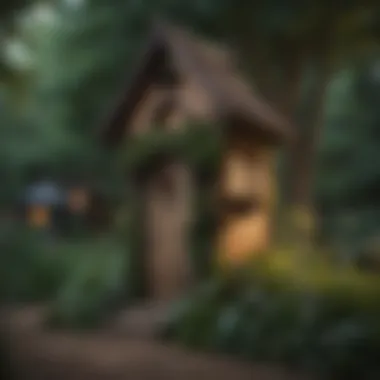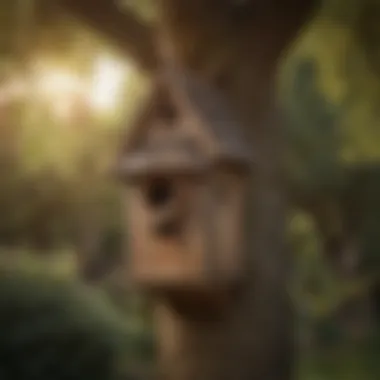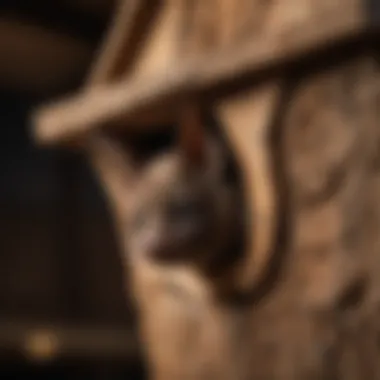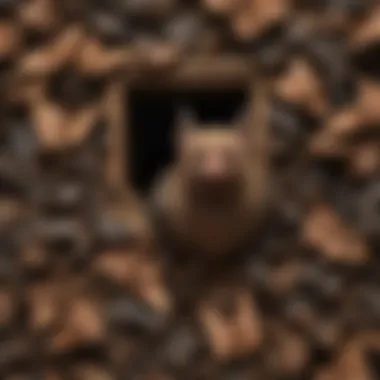Creating an Inviting Habitat for Bats


Intro
Attracting bats to your outdoor spaces can offer numerous ecological benefits. Bats are not just intriguing creatures; they are also vital for pest control and pollination. This article aims to provide a comprehensive overview of effectively encouraging bats to inhabit your bat house. We will explore their significance within our ecosystems, the ideal conditions required for a bat house, as well as practical guidance on placement and maintenance.
Understanding how to make your bat house a welcoming environment is crucial in fostering a successful relationship. Whether you are a homeowner seeking to enhance your garden or a gardening enthusiast wanting to invite these beneficial mammals, this guide contains the essential information you need.
Ideal Conditions for Bat Houses
Creating an inviting habitat starts with choosing the right conditions. Bats thrive in specific environments. Here are the primary factors that influence bat habitation:
- Location: Bat houses should be positioned at least 12 to 15 feet off the ground, preferably on a pole, tree, or building. Avoid putting them in shaded areas; bats prefer warm spots that receive full sunlight for a portion of the day.
- Temperature: Bats need a warm environment. A temperature of around 80 to 100 degrees Fahrenheit (27 to 38 degrees Celsius) inside the bat house is optimal. Consequently, selecting a bat house design that can retain heat effectively is essential.
- Ventilation: Adequate airflow is critical. Ensure your bat house has proper ventilation holes. This helps balance temperature and humidity levels, promoting a comfortable atmosphere for bats.
Types of Bats You May Attract
Understanding which bats you may potentially attract can guide your efforts in creating the best habitat. Here are some common species:
- Little Brown Bat: Often found in northern regions, these bats are versatile foraging creatures, helping control pest populations.
- Big Brown Bat: Present throughout North America, they are known to feed on beetles and other insects, making them beneficial for gardens.
- Mexican Free-Tailed Bat: Recognized for their speed, they often roost in large colonies, providing significant pest control services.
Placement Tips for Your Bat House
For successful bat attraction, placement plays a crucial role. Consider the following:
- Distance from Trees: Place the house away from dense tree cover to make it easier for bats to access and exit.
- Access to Water: Bats are drawn to areas near water sources, as they require hydration.
- Avoiding Disturbance: Keep bat houses away from areas with significant human activity, as bats prefer quiet environments.
Maintenance of Bat Houses
Once bats take up residence, maintenance is necessary to ensure their continued habitation. Regularly check your bat house for:
- Cleaning: Remove old droppings and debris to keep the environment hygienic.
- Repairs: Inspect for any damages, such as cracks or signs of wear, and fix them promptly.
"Bat houses can help control insect populations naturally while providing refuge for these ecological allies."
Closure
Attracting bats to your garden isn't just about placing a bat house; it is about understanding their needs and integrating them into your outdoor space thoughtfully. By following the guidelines in this article, you will foster an inviting habitat and contribute to your local ecosystem. Bats not only support pest control but also enhance biodiversity, making your home environment more vibrant and welcoming.
For more information about bats and their ecological significance, you may check out resources like Britannica or Wikipedia.
Engage further with communities on platforms like Reddit to share experiences or seek advice.
Understanding Bats
To create an effective bat habitat, one must appreciate the intricacies of bat ecology and their role in the environment. Understanding bats transcends mere curiosity; it impacts conservation efforts and enriches the local biodiversity. Bats are essential for natural pest control, pollination, and seed dispersal, contributing significantly to healthy ecosystems. Homeowners and gardening enthusiasts should recognize the many benefits these creatures offer, as they can greatly enhance not just the natural landscape, but human endeavors as well.
The Ecological Role of Bats
Bats are critical agents in maintaining ecological balance. They consume vast quantities of insects, with some species eating thousands each night. This pest control function helps reduce the reliance on chemical pesticides, promoting a healthier environment. Many plants depend on bats for pollination. For example, the agave plant, essential for tequila production, relies on bats for its reproduction. Additionally, bats help in seed dispersal, ensuring the propagation of various tree species, thus supporting forest regeneration.
"Bats play a key role in ecosystems by controlling insect populations and aiding plant reproduction."
Bats are also indicators of environmental health. Changes in bat populations can signal shifts in ecosystem dynamics, prompting timely interventions in conservation efforts. Hence, engaging in practices that support bat habitats not only aids in their survival but also fortifies our ecological frameworks.


Common Species of Bats
There are over 1,400 species of bats worldwide, each adapted to specific habitats and ecological niches. Some of the more notable species include:
- Little Brown Bat (Myotis lucifugus): Common in North America, it thrives in both urban and rural settings, often roosting in buildings.
- Big Brown Bat (Eptesicus fuscus): This species is adaptable and can be found across a variety of environments, including cities.
- Mexican Free-tailed Bat (Tadarida brasiliensis): Known for its long-distance migrations, this bat is prevalent in many regions of the United States.
- Hoary Bat (Lasiurus cinereus): Adapted to forest habitats, it is recognized by its distinctive fur.
Homeowners should familiarize themselves with these species to tailor bat house designs and placements effectively, thereby maximizing the potential for attracting local populations.
Bats and their Natural Habitats
Bats thrive in diverse ecosystems, from deserts to forests and urban areas. Understanding their preferred habitats is crucial for creating conducive environments. Caves, old buildings, and hollow trees commonly serve as roosting sites. Moreover, bats often prefer areas near water sources, as they rely on insects found in these regions. In gardens, bats are drawn to places with abundant flowering plants and diverse landscapes that attract insects. To cultivate a more inviting habitat, one should consider planting native flora, which supports local insect diversity and thus appeals to bats for foraging.
In essence, gaining insight into bats and their ecological roles not only cultivates a deeper appreciation but also lays the groundwork for practical measures to support their populations in your area.
The Design of a Bat House
The design of a bat house is critical to attracting and supporting bat populations. A well-constructed bat house can create an inviting habitat, helping bats thrive in your garden or yard. It is essential to consider the materials, dimensions, structure, and features that will make the house suitable for bats.
Choosing the Right Materials
Selecting appropriate materials for your bat house is vital. The materials should be durable and withstand weather conditions. Untreated wood is an excellent choice, as it is natural, provides insulation, and allows bats to cling easily. Cedar and plywood are commonly used, as both resist rot. Additionally, avoid pressure-treated wood, which can be harmful to bats. Ensure there are no harmful chemicals in the construction materials, as bats are sensitive to toxins.
Dimensions and Structure
The dimensions of the bat house significantly influence its usability for bats. A typical bat house should be about 24 inches tall and 14 inches wide, with a depth of at least 4 inches, although variations exist based on species preference. The entrance should be relatively small, around 3/4 to 1 inch wide, to provide security against predators. Make sure to include separate roosting chambers within the house to cater to social bat species. Spaces should be around 3-6 inches wide to accommodate different species, maximizing the chances of occupancy. A sloped roof can prevent rain from entering and provide additional protection.
Ventilation and Temperature Control
Bats require specific temperature ranges to thrive. Proper ventilation is would help regulate the internal temperature of the bat house. Small vents near the top can allow for air circulation. Additionally, placing the bat house in a location that receives adequate sunlight is crucial, as it helps maintain the warmth bats need, especially in cooler climates. The ideal temperature for a bat house is generally between 80-100 degrees Fahrenheit during the day. You may insulate the bat house using natural materials and design features that help maintain stable conditions inside.
Building a bat house with the right design and materials fosters an environment that encourages bats to settle.
When constructing a bat house, focus on combining functionality with appropriate design elements to ensure it serves its purpose well. This attention to detail enhances the chance of attracting bats and creates a sustainable environment for them.
Placement of the Bat House
The positioning of a bat house is crucial for attracting these creatures and ensuring their comfort. Many factors can affect the success of a bat house, from environmental elements to nearby resources. A well-placed bat house can increase the likelihood of habitation significantly. In this section, we will discuss the significance of thoughtful placement, taking into account location, height, orientation, and surroundings.
Selecting the Optimal Location
Choosing the right location for your bat house involves several considerations. Firstly, look for places with abundant insect populations. Bats primarily feed on insects, so proximity to water sources, gardens, or fields can enhance attraction. Additionally, avoid areas with high human activity, as bats prefer quieter environments.
- Ideal Locations:
- Near gardens
- Close to a pond or stream
- Surroundings with dense vegetation
Furthermore, observe the sunlight patterns. A south or southeast-facing position is preferable. Bats enjoy sunlight but will also seek refuge from harsh conditions. A spot that has shade during the hottest parts of the day can be a good compromise, offering warmth in cooler weather while providing shelter from excessive heat.
Height and Orientation Considerations
Height is another critical aspect when installing a bat house. It is generally recommended to mount bat houses at a height between 10 to 15 feet. This height reduces the risk of predation and makes the units less accessible to pets or children.
Orientation also plays a role in making the bat house attractive. Properly orient the bat house to face the prevailing winds. This generally means adjusting it to face south or southeast, which appeals more to bats. Wind exposure can help with ventilation, keeping the interior at optimal temperatures.
- Key Points for Height and Orientation:
- 10 to 15 feet above ground
- Facing south or southeast
- Avoid wind-shielding structures nearby


Creating a Bat-Friendly Environment
Creating an inviting environment surrounding your bat house is essential to further encourage bats to settle. Start by planting a mixture of native plants around the area. This can enhance the insect population, offering a stable food source. Avoid using pesticides, which can diminish the food supply and pose risks to bat health.
Also, consider minimizing bright lights in the area where the bat house is placed. Bats are nocturnal and overly bright lights can deter them. Instead, use low-intensity, motion-activated lights if necessary. Maintaining a natural habitat with decaying wood and leaves can contribute positively by providing roosting options besides the bat house.
Creating a bat-friendly environment is not just about positioning the bat house well; it's about creating a habitat that supports their lifestyle. The right placement of the bat house, considering all of these aspects, will significantly promote successful bat habitation.
Attracting Bats to Your Bat House
Attracting bats to your bat house is essential for creating a thriving habitat. Bats provide numerous benefits to the environment through pest control and pollination. They consume large quantities of insects, including mosquitoes and agricultural pests. Thus, encouraging bats to inhabit your space not only supports their populations but also helps maintain a balanced ecosystem.
There are several factors that influence bat attraction, including food sources, seasonal activity patterns, and environmental sounds that guide their navigation. Understanding these elements can enhance your success in drawing bats to your bat house.
Natural Food Sources
Bats primarily feed on insects, which vary across different species. By understanding their natural food sources, homeowners can create an inviting environment for bats. Some common food sources for local bats include:
- Moth species
- Beetles
- Flies
- Mosquitoes
Planting native vegetation in your garden can attract these insects, thus providing bats with a plentiful food supply. In addition, minimizing pesticide use will ensure an environment that supports insect populations. If you cultivate plants that bloom in the evening, like evening primrose or moonflowers, you can further attract moths and other nocturnal insects.
Seasonal Variations in Bat Activity
Bats exhibit seasonal variations in activity, primarily linked to their reproductive cycles and the availability of food. In the spring and summer months, bats are active during warmer nights when food is abundant. During these periods, ensuring your bat house is functional and accessible is crucial.
As autumn approaches and food sources dwindle, bats begin to prepare for hibernation. Some species migrate to warmer areas. Understanding these seasonal shifts can help you optimize the bat house for maximum attraction during peak activity times. Being aware of your regional climate and when bats are most active allows you to plan effectively, ensuring your bat house is utilized at the right moments.
Utilizing Bat Calls and Sounds
Bats communicate using echolocation and various vocalizations. By understanding and utilizing these natural sounds, you can further entice them to your bat house. Different species of bats utilize distinct calls, especially during mating season. Recording and playing back sounds specific to the species you wish to attract can sometimes draw them in.
Additionally, installing a bat call detector can help you monitor bat activity in your vicinity. This technology allows you to identify what species are present and modify your attraction strategies accordingly. Engaging in such practices promotes a deeper connection with the bat population and enhances your ability to create a welcoming environment for them.
"Bats are nature's pest controllers and play a critical role in maintaining healthy ecosystems."
By focusing on these elements—food sources, awareness of seasonal activity, and the effective use of calls—homeowners can significantly increase the likelihood of attracting bats. Ultimately, a thoughtful approach to their needs will lead to a successful relationship with these essential creatures.
Maintaining the Bat House
Maintaining the bat house is crucial for its longevity and for encouraging bats to take up residence. Regular maintenance ensures that the structure remains habitable and meets the needs of bats. By providing a clean and safe environment, homeowners can enhance their chances of attracting these beneficial creatures. This process includes periodic inspections, cleaning routines, damage repair, and monitoring bat activity. Each element contributes towards creating a thriving habitat for bats.
Inspection and Cleaning Routines
Establishing a regular inspection routine is vital for the upkeep of a bat house. It is recommended to inspect the house at least twice a year. Inspections ensure that there are no obstructions or signs of wear that could hamper bat inhabitation.
Look for:
- Cracks or holes in the structure
- Signs of water damage
- Accumulation of debris
Cleaning the bat house should be done carefully. Use protective gear, as handling bat droppings can pose health risks. A mixture of water and vinegar is often sufficient for cleaning. Remove any old refuse like guano, as this can harbor pests or diseases. Ensure that the interior is dry before closing the house again.


Regular cleaning not only prolongs the life of the bat house but also keeps it attractive for bats.
Repairing Damage
Over time, external forces such as weather can cause damage to the bat house. Repairing damage immediately is essential. Small cracks can allow unwanted pests to enter, while larger damages may expose bats to the elements.
Consider these steps for repairs:
- Assess the extent of the damage.
- Use appropriate materials that are suitable for outdoor use and safe for bats.
- Seal any gaps with non-toxic sealants or suitable wood fillers.
Keeping the bat house in good repair ensures that it remains a safe and secure environment for bats, helping to maintain their populations.
Monitoring Bat Activity
Monitoring bat activity is an important aspect of maintaining a bat house. It involves observing when and how often bats enter and exit the house. This information can give insight into their habits and preferences. It would be beneficial to take note of patterns during different seasons.
Tools for monitoring:
- Bat detectors can help identify species and their calls.
- Simple observation logs can track daily or seasonal activity.
- Smartphone apps may assist in recording entries and exits.
This monitoring not only helps in assessing the health of the bat population but also informs future maintenance steps. By understanding their behavior, homeowners can make informed decisions on any alterations needed to the habitat.
Legal and Ethical Considerations
Creating a habitat for bats is not merely a matter of convenience; it comes with legal and ethical responsibilities. Understanding the framework of local wildlife laws is crucial. These laws exist to protect bats and their habitats from exploitation and harm. It is essential to know what measures are in place in your area to ensure that your efforts to attract bats do not inadvertently violate regulations. For instance, some bat species are protected under the Endangered Species Act in the United States. Engaging with local wildlife authorities helps clarify which species you may welcome into your bat house.
In addition to legal compliance, ethical considerations arise in how we interact with local wildlife. Bats provide numerous benefits, such as pest control and pollination. By fostering a supportive environment, you engage in a reciprocal relationship that benefits both you and the bats. To proceed responsibly, here are a few vital elements to watch:
- Research Local Laws: Know what permits may be necessary to build or maintain a bat house.
- Respect Natural Habitats: Ensure that setting up your bat house does not intrude on existing bat habitats.
- Avoid Disturbance: Limit interactions with bats to protect them from stress and potential harm.
Remember, fostering bat populations is not just a personal project; it's a contribution to biodiversity.
Understanding Local Wildlife Laws
Each locality has unique regulations regarding wildlife conservation. Familiarizing yourself with these laws is imperative for any homeowner wanting to attract bats. Laws may dictate when it is acceptable to program alterations in outdoor spaces, especially concerning the breeding seasons of bats. This knowledge prevents disturbances during critical life stages, such as birthing and feeding. Furthermore, you may discover if certain bat species are under special protection in your area, thereby guiding your approach with sensitivity and responsibility.
Checking with local wildlife agencies or consulting state or federal regulations assists in your compliance. Online platforms like Wikipedia can provide a starting point to understand broader conservation efforts and the importance of local law.
Best Practices for Supporting Bat Populations
Ethics extends beyond legality; it includes the manner in which you promote sustainability and support populations of bats in your garden. Here are several best practices to consider:
- Educate Yourself: Understand bat behavior, diet, and habitat needs. This knowledge will inform your decisions.
- Provide Natural Food Sources: Encourage insects to thrive in your garden to create a natural food source for bats. Consider planting native plants that attract moths, beetles, and other insects.
- Monitor Bat Activity: Keeping logs of bat appearances can provide valuable data. This understanding of local bat populations helps you adapt your efforts.
- Establish Partnerships: Collaborate with local conservation groups. Engaging in community efforts enhances the effectiveness of your initiatives.
- Limit Use of Pesticides: Reducing or eliminating pesticides in your garden ensures that food sources remain plentiful and healthy.
Implementing these practices fosters long-term sustainability within your ecosystem and creates genuine benefits for local bat populations.
Finale
The significance of concluding an article regarding creating an inviting habitat for bats cannot be overstated. It offers a chance to consolidate the key insights and underscore the ecological impact of fostering such environments. As we have explored, bats provide crucial benefits including pest control and pollination services, making their conservation essential for biodiversity and ecosystem health.
The Long-term Benefits of Bat Conservation
Bat conservation goes beyond the immediate aesthetic or practical benefits of attracting bats to a bat house.
- Biodiversity Support: Bats play a critical role in maintaining ecosystem balance. Their dietary habits help control insect populations, which can reduce the need for chemical pesticides. This natural pest control can lead to healthier gardens and more sustainable agricultural practices.
- Pollination: Many bat species are pollinators, vital for the reproduction of numerous plants. By creating habitats that attract bats, homeowners can indirectly support the growth of fruit trees and flowering plants, contributing to a more vibrant outdoor space.
- Educational Opportunities: Setting up a bat house and maintaining the habitat offers educational insights for families and neighbors. Observing bats can ignite interest in wildlife conservation among children and adults alike, fostering a community focused on environmental stewardship.
- Increased Property Value: Properties known for allowing native wildlife can see an increase in value. Homeowners may find that an inviting habitat for bats enhances the natural appeal of their land, making it stand out in the competitive real estate market.
- Sustainable Practices: Engaging in bat conservation promotes sustainable gardening and landscaping practices. Homeowners can take pride in knowing they contribute to global efforts for wildlife preservation.
The long-term commitment to bat conservation not only benefits the bats themselves but reinforces a homeowner's role in supporting our planet's ecosystems. Recognizing their importance ensures these beneficial creatures continue to thrive while enriching our outdoor spaces.







